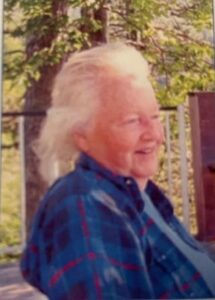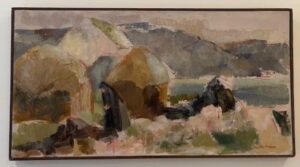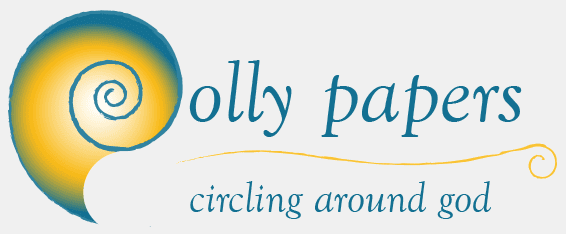When they brought her to be baptized, she was given her mother’s name, Aurelia. But when her father peered into her cradle he announced, “her hair looks like thistledown”. Her infant halo of white thistledown hair was an aura that never left her, especially when that hair turned the soft white of her later years. The name defined her; her will o’ the wisp ways, her desire and her decisions to go wherever the wind blew and her spirit led; her unique, fey wonder and curiosity about the world. And thus, the beautiful child with the thistledown hair was, from that day on, known as Thistle. An accomplished and prize-winning artist, a sailor, a life-long adventurer and my father’s much younger half-sister, she was my aunt and my godmother.
Friends and acquaintances used to ask me about her name, imagining that someone called Thistle must be a prickly person, like the purple Scottish wildflower.
Sometimes that was true. She was determined to follow her inner guiding light and not always patient with those, particularly my accountant father, who could never understand yet another Thistle exploit. But I believe it was that spirit which allowed her to choose exactly how she moved through life.
Thistle showed me how to be an independent woman that followed her talent, her dreams and sense of adventure wherever it might lead.
She was the young woman who once took me, a shy, fearful ten-year-old who had hardly ever skied, to the top of Spruce Peak in Stowe, Vermont and told me, “just head downhill.”
Years later, she was the aunt who showed up at Columbia- Presbyterian hospital in Manhattan a few days after my first child was born. Since her visit happened to be on the Fourth of July, she came equipped with champagne and firecrackers, popping the cork of the former and setting off the latter. A moment later, what appeared to be the whole maternity staff rushed into the room, believing a bomb had gone off. They gave Thistle quite a dressing down while my baby girl slept right through it!
Thistle won a Fulbright to paint in India in 1960. Somehow she once managed to get herself invited to take tea with the Maharajah of Jaipur. While sitting on the terrace, she saw one of his handsome horses in the pasture and asked if she could paint it.
“Of course you may. Please come back in a day or two so he will be ready.” She returned at the appointed hour and found, to her amazement, a groom next to the horse holding a large brush and a bucket of gold paint; “to paint the horse!”
The Thistle moment that I cherish above all is the day she told me the details of the trip which she had arranged to fulfill Mum’s lifelong dream to visit Ireland. Thistle changed her own trip back home from India in order to spend time there with my mother. Two months later, my mother died, tragically and violently. Finally, all those many years later, it was during that telling that I was able to see into the troubled, dark places that my mother had long carried within. Better than all the rest of my family, Thistle understood my mother; her struggles, her hopes, her very soul. In the telling of that tale, I saw a side of my aunt I hadn’t known previously: her deep wisdom about human nature and an intuition that guided her understanding. No longer was she simply the fun-loving, unpredictable, risk-taking adventurer. That day she became a true godmother, a God-given mother to me.
 Thatch-roofed Irish Cottages. Aurelia C. Brown 1961
Thatch-roofed Irish Cottages. Aurelia C. Brown 1961
Thistle helped me laugh and helped me weep. She showed me that I could be equally at home sleeping by a campfire in the woods or dining with the rich and the famous. She taught me to stretch myself artistically, intellectually and spiritually. She showed me that what the world thinks I should be is never as important as how my Spirit is leading me.
Thistle has been gone for many years. So why do I write this now?
Because on this October day, as I see thistledown departing its earthbound flowers; as wisps of white quietly leave on the breeze and knowing that soon they will all be gone, I like to imagine that Thistle too floated off on a gentle breeze at the end. How beautifully they drift into the sky! How lovely are they in their dying, leaving a blessing at the end of their life. As Thistle-down did for me.

7 Responses
Very nice. I remember visiting her in Maine.
Oh Polly, I have tears in my eyes and your very meaningful words and wisdom. How we cherish our connections and likely treasure them even more as we age! thank you, I love thinking of you and all the memories we shared in Concord. Peace be with you.
She sounds like a great person. Glad you had her in your life.
Thanks for sharing.
What wonderful memories of a special person. Would that we could all have such mentors/guiding spirits in our lives. You were fortunate to have her – and I am sure, she to have you.
So glad she was there for you!
Thistle down are seeds that use the wind to fly far, then settle down to grow a new plant. Although prickly, I have seen the western goldfinches coming back again and again to the same plant…to feed on the seeds. I love Thistle’s painting of the cottage.
Polly – Thank you for sharing your memories about Thistle – obviously a very special person who helped to make this world a better plade for all who knew her.